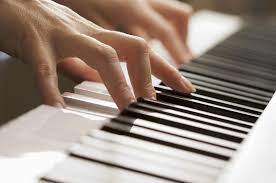The Theory of Musicality: Chords 201
Nope, not those kinds of Slash chords.
If you’ve been keeping up with my introduction to chords and chord symbols over the past few weeks, congratulations! With a little bit of time at the piano, you should now be familiar with all these chords: Major, Minor, Major 7th, Minor 7th, Dominant 7th, Sus2, Sus4, Add2, Open 5th, and (Add)6. That’s a lot! With little more than this information, you can now open up any pop fake book and interpret most of the chords in pretty much every chart. Go you! (If you’re just now joining us, you can get totally caught up in no time by starting HERE) However, our ambitious journey doesn’t end here, we’ve only just started! This week we look at a super fun (and super easy) concept: Slash Chords.
Before we dig into this week’s lesson, I’d like to take a minute to chat why we use chord symbols in the first place. Like we’ve touched on before, chord symbols are a musician’s form of “harmonic shorthand”; they tell the musician at a glance exactly what notes are in the harmony. But the question remains: since people already write down the notes in sheet music, why should we care about chord symbols?
tl;dr: chords are super great and helpful, but you should probably read proper sheet music too
Look at all these squiggles! Ain't nobody got time for that.
Formalized music notation used in standard music notation (all those little “squiggles climbing over a fence”) is a fantastic system for writing down exactly what notes you want played, when to play them, and how long to play them for. This system developed over hundreds of years, starting with monks and scribes elaborately penning down sacred music, and evolving into the precise system we use today. Even so, it isn’t a perfect system; while it may work particularly well for Western art music (see “classical music”), it is not the best system to capture the nuances, and even more the actual practicality of music-making for countless genres of music.
Bobby McFerrin and Yo Yo Ma
Bobby McFerrin (if you don't know who that is, google him ASAP) tells a story about his cellist friend, Yo Yo Ma. Seeking to expand his knowledge of improvisation, he travelled to a remote village in Botswana to share his music, and experience the local musical culture of the people there. In one anecdote Yo Yo Ma found himself transfixed by a song that the village shaman sang for him. He quickly got out his manuscript paper to write down the tune, and asked him to repeat the song so he could ensure that he wrote it down accurately. But when the shaman repeated his song, the melody was different! McFerrin goes on to say:
“And Yo Yo is saying But that’s not the piece you sang before. The shaman laughed and said “The first time I sang it there was a herd of antelope in the distance and a cloud was passing over the sun.” So this is the part that we lost. Every time a piece of music is played, one time there is a herd of antelope, and one time there’s not. And we turn in these cookie-cutter performances. Everything is so laid down and regimented and locked-in and so rehearsed, that they squeeze the life out of it. It no longer has any life in it because no one is open to surprise, no one is open to any spontaneous event that can happen. Everything is just dictated, and this is the way it’s gonna be. I think that’s the part that we’ve lost.”
This isn't to say that formal music notation is too fussy to be practical, but that it might not be the best solution for every kind of music. After all, there's a huge musical world outside of Western art music! (Check out the segment with Bobby McFerrin here, it's a great read!)
Standard musical notation not only struggles to give a musician freedom to improvise, but it also can be very cumbersome! This is really where I find the biggest payoff for the chord symbol system: in genres like jazz, pop, and rock where exact musical arrangements may not be necessary, the chord symbol system gives freedom to the musician to more easily interpret the harmony. In layman’s speak, you’re not wrestling over trying to read a bunch of little notes, but rather getting the gist of what the harmony is, so you can actually get the notes under your fingers and spend your time playing, not squinting at squiggles.
This isn’t to say that the chord symbol method is watering-down the music. Rather, it relies on the musician’s stylistic knowledge of the genre. This is why listening is so important! If you want to play great blues licks, listen to great blues players. If you want to sing great R&B riffs, listen to great R&B singers. And for goodness sake, if you want to play great jazz solos, listen to great jazz solos.
Standard music notation is like a very elaborate recipe from an award-winning chef: Follow these instructions exactly, use the freshest ingredients, and execute the preparation well and you will get the award-winning meal you hope for. The chord symbol system follows the same pattern, but is more of a “passed down from your grandmother” sort of recipe: all of the same rules apply, but you have more freedom to mix things up… provided that you know the basics first. You don't want to disappoint your grandmother, so you better practice rocking out with your chords.
With all that said, let’s roll our sleeves up and get into today’s topic, slash chords! In the most simple sense, a slash chord is just a chord played in the right hand, with a note other than the root played in the left. That’s it. Seriously.
In all of our previous examples, we’ve been looking at how chords are constructed in the treble clef (piano, right hand). They have all been in root position, meaning that the root of the chord is the lowest note in the chord. For a C major 7, that means that we would start with the C on the bottom, followed by E, G, and B stacked right on top. But what about the left hand? Up until now, the left hand would simply play the root note in the bass clef (left hand), which is a C. Pretty easy. What bass note would the left hand play for an Fm7 chord? You got it, an F. How about an Absus7? Ab! D7(b9 #11 b13)? If you panicked a little but said D, you are correct!
However, sometimes you might not want the bass to play the root note. If the bass is always playing the root, it can sound boring and predictable. It can also be jumpy since it has to hop around all over the place! With slash chords, you can quickly and easily see what note to play in the left hand. (In a future lesson, we'll look at how slash chords can even help to simplify some really complex jazz chords into easily digestible bites! Yum!)
Let's look at some examples of slash chords. Below we have an example of a C/E chord. The C tells us that we are to play a C major triad in the right hand, and the part after the slash tells us to play an E in the left hand. This "C over E" chord looks like this:
When you take a chord and flip the notes up in such a way that the root is no longer the lowest note, we call that an inversion. (For more info on chord inversions, check it out here) The cool thing about slash chords is that, with the right and left hands playing together, we can get an inverted sound but still play all the right hand chords in root position. Eventually, you will find new chord voicings that you like, but when you're just starting out it is so much easier to think of chords in root position.
What happens if we put the next note in our chord on the bottom? What would we call it?
Why, a C/G! C major triad in the right hand, G in the left hand.
Now let's look at a chord with four notes in it:
Inversions of a C7 chord
In this example, we've taken a C7 chord and simply inverted it, each time taking the bottom note and moving it to the top.
In these three examples, we are just using the other chord tones to play in the left hand. But be creative! You can really play anything in the left hand and make it a slash chord. Depending on how the notes sound together, you may get a combo that creates tension or release. Depending on the bass note that you add, you may actually create a new chord altogether! Check out this example:
Slash chords, and the composite chords they create
Some of these combinations create some fairly advanced chords, but there are a few that we can understand at this point in time. Check out the Eb/C chord. The first thing to look at is the root in the left hand. We know that it's something over C, whether it's a C chord or not. Keep that in your back pocket for now.
Now look at the right hand. That low Bb is doubled, so we can ignore it. What's left is a perfectly stacked Eb Major triad: Eb, G, and Bb. Now, let's put those things together! C on the bottom, then Eb, G, and Bb on top. What does that sound like? A Cm7 chord! Check out some of the other chords and see if you can recognize any other similarities with chords you already know!
Now it's your turn! Find some music that has slash chords in it and go to town! Or you can get even more creative by discovering your own slash chords! Start with a triad in your right hand and the root in your left, and just try different root notes! Walk your left hand up and down, trying all the white and black notes with your triad until you get to a sound you like. What chord is that, what is it called? C/Ab, D/C... even try bigger chords like BbM7/C, EbM7/C, D7/E... have fun! Keep a notebook, writing down your favorite combos, I want to hear all about it in the comments!
Coty Cockrell is a freelance musician and artist living in Brooklyn, New York working as a jazz pianist/singer, professional ballet accompanist, theatrical music director, and vocal coach. When not teaching private lessons, he performs in the NYC area as well as internationally.
To inquire about booking or to schedule a trial piano or vocal lesson, please visit the Contact page.













